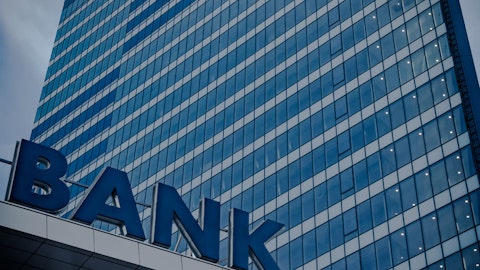Timothy Spence: Yes. I’ll leave it to Bryan to provide more detail, drag. But I’m glad you asked that question because if there is one frustration, I have, in particular, on the way that the media is reporting on economic activity is the treating the world like it’s deterministic and it’s not, right? It’s stochastic in terms of the outcomes here and while you can see the slowdown in inflation, you can see some slowdown in the economy, in particular, in specific sectors. It’s just hard to be certain, given the impact of deficit spending and the way that has continued to provide a buffer against any consumer slowdown. And I think the possibility that maybe we return to a world where recessions in the US are regional as opposed to being national phenomenon, which I think people have forgotten about because of the last two were driven by global health pandemic and a global financial crisis.
So we’re trying to run the company in a way that provides an outlook on the expected outcomes in the middle of the distribution, but that manages to a much more stable return profile in the event we get into either of the tails, right, more robust economic growth, stickier inflation on one side of the equation and therefore, the Fed not being able to come off of its restrictive policies and stuff. And the other alternative, where I think you have to say you have some sort of a geopolitical event that creates a price shock and energy or another supply chain issue or otherwise, which could trigger an unexpected slowdown. So Bryan, maybe a little color on the upside.
Bryan Preston: Yes, absolutely. I think the scenario that you’re laying out there with fewer Fed cuts, continued strength from an economic perspective, that’s not a remote scenario in our view. We feel like that is something that could very easily happen, especially in the first half of the year as we continue to see potentially some strong resiliency from the consumers. What that means for us, and it’s a big part of the actions that we’ve taken thus far is that we think that could cause the long end of the curve to move up a little bit, that would actually be beneficial for us as we get an even greater benefit from the fixed rate asset repricing. We’ve talked previously that full year impact of fixed rate asset repricing should generate about $300 million of annualized run rate NII improvement.
And that number would look even better if we saw that long and move up. It also is part of the rationale associated with shifting some of our securities into HTM. So a stronger economy is one that we’re actually would obviously always hope for because we’re very well positioned for that. To quote Jamie, you can’t spell flexibility without FITB. That’s something that we have been very focused on and recognizing that we can be wrong on both sides, the economy weaker or stronger, and we’re well positioned for that.
Gerard Cassidy: Very good. Thank you. And then another bigger picture question, Tim. I think you touched on your middle market business, customers grew 11% year-over-year. And then later in the comments, I think you said that you got to take these customers or clients from maybe other banks. How are you guys doing that? And then if you could tie it into that loan-to-deposit ratio, I think you guys said you’re at 72%. What’s the ideal level that you eventually like to get to? Thank you.
Timothy Spence: Yes. I mean I think it’s a combination of things, Gerard. The first one is we’ve been very deliberate to select a few places and invest multiyear when we think about how we invest strategically, right? So the Southeast is obviously a key point of focus there. And I know a lot of people are investing in the Southeast, but it bears reminding that we’ve been in nearly every one of the markets down there for more than 15 years. And we’re not running small LPOs. We have more than 200 client-facing people in those markets across commercial banking and wealth management alone. And then like another 1,700 that said in more than 300 branches. And the brand is seeded in those markets. So those investments when you make them, you make the investment in year one, but they don’t actually hit the sort of peak benefit until year five or six.
So you have this accumulation I guess a coiled spring for lack of a better term that supports then more sustained growth. We have the same benefit in the Midwest in Chicago, in particular. I mean, we added nearly 100 new quality relationships in Chicago in the middle market alone last year and have been gaining share pretty steadily at least if you use the FDIC deposit share measures as the guide. In Chicago because we’re still seeing the benefits that we got out of the combination between Fifth Third and MB in those markets. The other area that we are winning, where we win is through the strength of the treasury management and the capital markets platform, which really is a middle market-focused offering for Fifth Third. About 1/3 of the new quality relationships we added in treasury management last year were treasury management only.
So as opposed to being a follow-on product that you deliver into a customer that you lend money to, they’re actually contributing to the relationship acquisition. And that’s an engine that just wouldn’t have existed here in the past, and I think still doesn’t exist inside most of our peers.
Gerard Cassidy: Thank you.
Operator: Your next question comes from the line of Mike Mayo of Wells Fargo Securities. Your line is open.
Timothy Spence: Hey, Mike.





